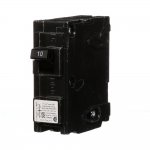sheldonrf
Member
- Location
- Washington, DC, USA
I have a design I am completing which will be installed in various locations around the US for the Federal Government. The installation will be at radio station tower locations.
There is a 30 amp 120 volt feed and I need two 20 amp 120 volt circuits powered through this feed. The 30 amp circuit is capable of handling the loads as they are minimal wattage for each item. (1200 watts for one and 600 watts for the other)
I need a means of disconnect and the items are both required to be on a 20 amp max disconnect per the manufacturer. I have two thoughts for how to do this (other than in-line fuses which I don't like and do not want to use)
1 - Install a single phase panel and power only one leg of the panel
2 - I have seen some din rail mounted circuit breakers that could be placed in a Hoffman enclosure, but I do not think they are code compliant due to the fact that the Hoffman enclosure is not UL listed for that purpose and the cover must be removed to access the breakers
So, does anyone know if I can power a single phase panel with 120 volts? or am I mistaken about the Hoffman enclosure? Thank you in advance for your help.
There is a 30 amp 120 volt feed and I need two 20 amp 120 volt circuits powered through this feed. The 30 amp circuit is capable of handling the loads as they are minimal wattage for each item. (1200 watts for one and 600 watts for the other)
I need a means of disconnect and the items are both required to be on a 20 amp max disconnect per the manufacturer. I have two thoughts for how to do this (other than in-line fuses which I don't like and do not want to use)
1 - Install a single phase panel and power only one leg of the panel
2 - I have seen some din rail mounted circuit breakers that could be placed in a Hoffman enclosure, but I do not think they are code compliant due to the fact that the Hoffman enclosure is not UL listed for that purpose and the cover must be removed to access the breakers
So, does anyone know if I can power a single phase panel with 120 volts? or am I mistaken about the Hoffman enclosure? Thank you in advance for your help.




